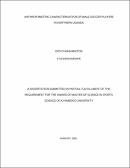Anthropometric characterisation of male soccer players in northern Uganda
Abstract
The study purpose was to assess anthropometric characterisation of male soccer players in Northern Uganda. One hundred ninety-two players aged between 16 and 36years were sampled taking into account their playing positions as goalkeepers (GK), defenders (DF), midfielders (MF) and forwards (FW). Descriptive cross- sectional design was employed. The ISAK protocol was considered to measure anthropometric variables: weight; height; circumferences; n_/10; skinfolds, n_/2; and breadths, n_/6. BMI n-1, %BF, and somatotype were determined. The data was analyzed by STATA version 14C, Bartlett’s test for hypothesis done and level of significance was set at (p<0.05). The results showed that GK (71.3kg ± 4.5; 177.5 cm ± 6.7) were the heaviest and tallest compared to others and MF (67.2 kg ± 6.6; 171.6 cm ± 5.9) were the lightest and shortest.Majority (82.8%) of the players had normal BMI, with higher mean %BF (16.3%) than the recommended fat percentage(6-13%) and they showed dominancy in mesomorphic somatotype.There was no significant difference (p ≤ 0.05) in; BMI (p=0.30, F=1.22), %BF (p=0.22, F=1.49), endomorph (p=0.20, F=1.57), and ectomorph (p=0.56, F=0.68) with exception of mesomorph (p=0.01, F=3.65) that showed significant difference among players in different playing positions. The study concluded that players in Northern Uganda were generally heavier and taller with most of them having higher body fat percentage than the recommended fat percentage for soccer players. Therefore, this study recommended that coaches should design training that cater for the anthropometric requirements of each playing position to improve soccer performance.
Keywords: Anthropometry, body composition, soccer performance.

